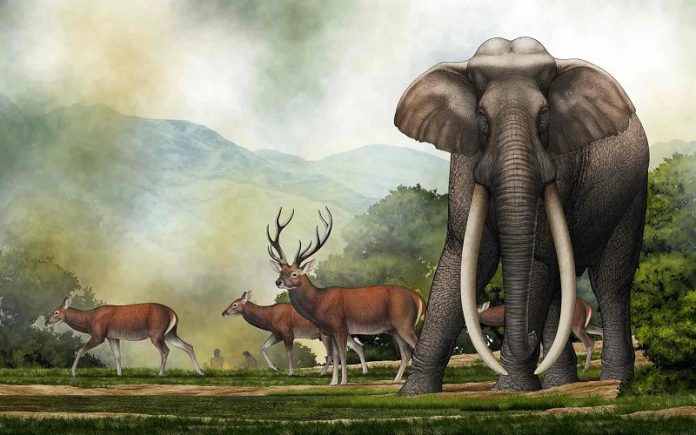
A giant fossil skull of an extinct elephant, discovered in the Kashmir Valley of northern India, is helping scientists uncover new details about the evolution of prehistoric elephants.
The fossil, found alongside 87 stone tools used by ancient humans, was excavated in 2000 under the leadership of Dr. Ghulam Bhat from the University of Jammu.
Recently, an international team of researchers, including scientists from the Florida Museum of Natural History, the British Museum, the University of York, and other institutions, studied this fossil to better understand its age and evolutionary significance.
Their findings were published in the Journal of Vertebrate Paleontology.
The skull belongs to the Palaeoloxodon, a group of straight-tusked elephants that were among the largest land animals to ever exist.
These enormous creatures could grow up to 4 meters tall at the shoulder and weigh between 9 to 10 tons.
However, what makes the Kashmir skull unusual is its lack of a thick skull crest, a feature typically seen in other Palaeoloxodon fossils found in India.
This lack of a prominent crest on the skull has puzzled scientists for years.
The skull crest was believed to become more pronounced as the elephant matured, so experts initially thought that this feature could help distinguish different species of Palaeoloxodon.
The new research suggests that by studying the teeth and other features of the skull, it is possible to tell the difference between species.
Dr. Steven Zhang, one of the paleontologists involved in the research, explained that the Kashmir skull belonged to a fully grown male elephant. However, despite its size, the skull lacks the crest seen in other adult Palaeoloxodon elephants from India and Europe. This suggests that the Kashmir elephant may represent a different species altogether.
The researchers also found that the features of the Kashmir skull closely match another mysterious skull discovered in Turkmenistan in the 1950s.
The Turkmen skull, like the Kashmir one, lacked a prominent crest but shared similarities with a known European species called Palaeoloxodon antiquus.
Some experts thought the Turkmen skull was just an unusual example of the European species, but the Kashmir skull now suggests that these two fossils represent a distinct species called Palaeoloxodon turkmenicus.
By examining the tooth enamel and stone tools found with the skull, the researchers determined that the Kashmir elephant lived during the Middle Pleistocene period, around 300,000 to 400,000 years ago, similar to the Turkmen specimen.
This reinforces the idea that these fossils belong to a species that once roamed from Central Asia to northern India.
With this discovery, scientists have gained valuable insights into the evolutionary history of these massive, extinct elephants and their spread across different regions. The findings offer a clearer picture of how these prehistoric giants evolved and provide new clues about the ancient world they once inhabited.



